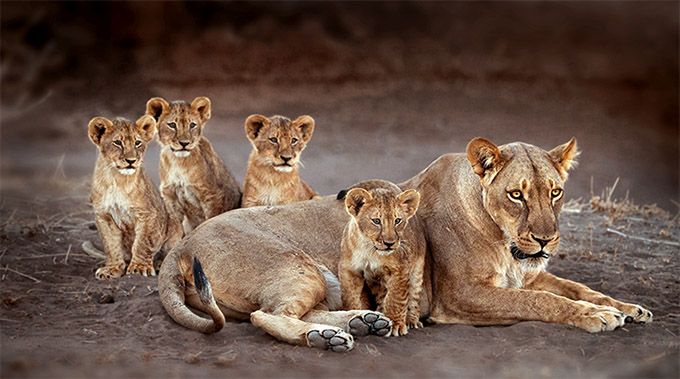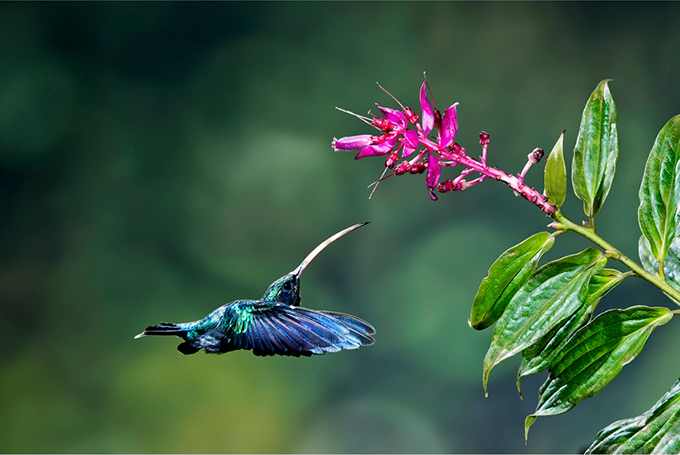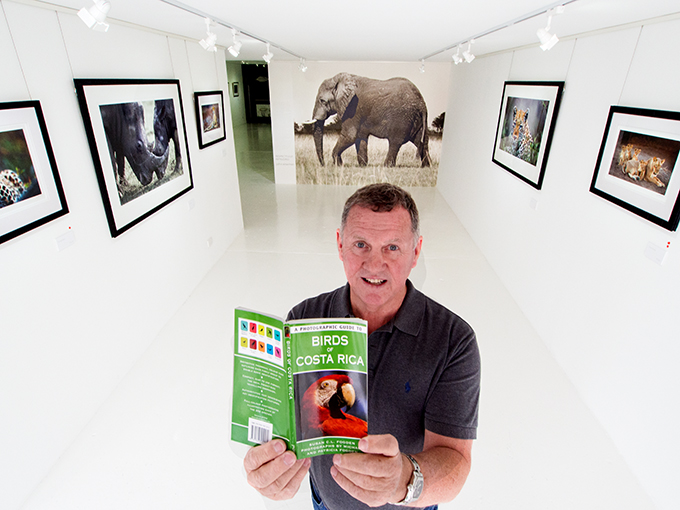Archive for August 2014
WISEMAN ON SAFARI @ Brisbane’s Maud Gallery
Respectfully Intruding by John Wiseman @ Maud Gallery, Brisbane
August 6 – September 13, 2014. The exhibition was opened by Ken Duncan on August 8.
.
John Wiseman’s photography exhibition Respectfully Intruding at Brisbane’s Maud Gallery presents an invitation to go on safari and peek over his shoulder while he observes and photographs wildlife on the African savannah or in the Costa Rican rainforest. Luckily for us his invitation is to the gallery and the trials and complexities of journeys to exotic places are made easy for us. He also saves us the trouble of waiting, waiting, fighting impatience and the agonies of cramped photography vehicles and observation hides. Dust, flies, mosquitoes, things that will sting or eat you are not part of Wiseman’s plan. We are also spared the burdens of travel, airports, border guards with guns and the grind of life in these exotic lands. What we are given are his photographs.
.
.
In the white spaces of Maud Gallery, a kind of ‘safari of wonder’ is encountered –as the visitor wanders through the exhibition of wildlife and flora images. Rhino, elephant, leopard and lion of Africa inhabit the front room. Then in contrast to the ochres, browns and blacks, there are birds, flowers, frogs and snakes in green, yellow and turquoise of the rainforest that inhabit the large inner gallery. The bridge between these two environments is the photography style and vision of John Wiseman.
.
.
We are no stranger to subjects like these as they have adorned National Geographic magazines, a thousand Attenborough ‘Life on Earth’ TV programs and countless coffee table books. We may have become so familiar with these subjects that these new works may just become just another ‘one of those’. But I would say look again. Wiseman is no quick snap wildlife shooter – his images exhibit careful consideration for subject and the moment captured. His arrangement and design of the image and concern for lighting takes images to the perfect moment that we think only Photoshop fakery could reveal. But these are real images from single exposures straight out of the camera without much post capture treatment.
.
.
Individual images stand out and draw your attention to the framed photograph – for those who love cats, a stunning image of a leopard with clear eyes will hold you in it’s mesmerising and piercing gaze. In another photograph entitled, ‘Family Portrait’, a lioness and four playful cubs look off camera with ears pricked up, attention aroused – for the viewer there is an ability to take in that frozen moment. Someone with an understanding of safari photography will wonder low long and what patience it took for Wiseman to get such an image.
.
.
In the Central American space humming birds dance and glide in many frames. Frozen in flight, something that is particularly difficult to photograph, these birds are like airborne jewels with iridescent colouring attracted to equally colourific blooms. Once again Wisemans mastery of technique gets the photo but his sense of design, moment of capture, concern for background and subject placement make these extraordinary photographs. A multiple electronic flash setup is used to create these images and in a few photos Wisemen has synchronised the flash with a slow shutter speed allowing a frozen moment, as in the other images, to be combined with the blur of the wings in the longer moment of capture. For me this tells the greater story of the little bird’s hovering capacity and the beauty of this feathered flight.
.
The Costa Rican rainforest also has its share of frogs that perform for Wiseman’s camera. Colours, backgrounds, movement and clarity once again reflect Wiseman’s fascination for the natural world. Other images that evoke response include a toucan in the rain, and the sinister shapes of snakes, the most beautiful of which hides camouflaged in the framework of a heliconia flower.
.
.
In an artist’s statement Wiseman states that he finds in his photography adventures: ‘The intoxicating excitement of the animals of Africa; the size, beauty and grace of these creatures and the love of the chase.’ And that most certainly is evident in the photographic works presented to us in this exhibition. And unlike many who venture, or have in the past, ventured into exotic lands in search of the hunt and big game with a gun – John Wiseman has been, and shot big and small game, and presented his trophies of the living things for us to observe and share his excitement and wonder of these things.
.
.
Doug Spowart 18 August 2014
.
Texts and installation photos © Doug Spowart 2014 Photographs from the exhibition © John Wiseman
.
.
.
BOOKS AS ART: 30 YEARS IN THE MAKING – Catherine McCue Boes
BOOKS AS ART: 30 YEARS IN THE MAKING by Catherine McCue Boes
Bundaberg Regional Art Gallery – 14 May – June 29, 2014
.
An observation of artists and artmaking in the regions…
.
Artmaking and artists from the regions are constantly sidelined by the power of proximity that pervades these ‘blessed’ centres of art and culture. People who make ‘real art’, it seems, come from places where populations are concentrated, like ‘big cities’ or localities where a place of learning (university) or an uber vibrant arts community exists. In Australia the place names of Sydney, Melbourne, Adelaide, Hobart and perhaps Bris-vey-gas, are part of a roll call of significantly charged places for artmaking, presentation, commentary and critique. *[Note: artists’ books have a wider community of practice that is more inclusive due to the fact that regional centres tend to present events, awards and workshops that bring the city and country together. SEE https://wotwedid.com/2013/05/13/2013-libris-awards-the-judges-view/]
.
With this in mind, then consider my surprise when I recently encountered an exhibition of artists books at the Bundaberg Regional Art Gallery. The main gallery held one of the largest exhibitions of artists books I’ve seen for some time. The show was more impressive because it was essentially the book works of one person with additional books by others coming from the artist’s collection. The exhibition, entitled Book as art: 30 years in the making, was by Catherine McCue Boes a local Bundaberg artist. As the title implies the exhibition encompasses a significant period of time and the life of the artist.
.
.
Engaging with the artists books on display was a challenge – I walked around the space, glancing at and visually grazing the works on display. In keeping with the gallery display norm for artists book display the books were not for touching with many in vitrine glassed cages. Many books were the concertina form that allowed for easy reading and connection with the narrative. The artist also presented alongside the books wall works to give the reader an idea of the contents of the book.
.
.
After my initial viewing, the sheer volume of the work on display and the demands that such a volume of complex and at times conceptually dense places on the viewer, I had to go away and come back to the gallery for a second viewing.
On my return I was drawn to a number of the accessible concertina books. The first of was, In Paris 2012, which dealt with the artist’s personal experience of walking in Paris and the extraordinary things experienced. The book’s plain white paper surface is inscribed with diaristic jottings, a quick unfinished drawing of the Eiffel Tower, a textural pattern element, and deep-etched monochrome photographs of sculptures and architectural details. A pink abstracted form with a pigment-bled edge repeats over many pages – is it a memory of a figure walking in the rain with an umbrella or is it a self-portrait?
.
.
In another work, Preserved in Australia, an old Kodak folding camera has the concertina bellows extended ready for use. Spilling from the rear of the camera explodes a concertina of 20 or so images attached to the viewing hood. The book is derived from a period of time where the artist worked in Roebourne in Australia’s north west. The photos are from the early 1900s, loaned by their owners – residents from Roebourne as well as from the local Historical Museum. McCue Boes has metamorphosed the camera and it’s image legacy into a device for viewing history.
.
.
An early book, First Revolution (Macbeth) Lithographs 1989, represents the artist’s reference to the Shakespearian theatrical character of the same name. These stone lithographs are accompanied by screen-printed texts on the verso page. In the style of the livre d’artist this large format book with it’s thick deck-edged pages and codex binding make it a strident piece of work. Whilst the book is firmly enclosed in a vitrine and opened to one page only, individual prints from other pages of the book are presented as a framed artworks on the wall.
The First Revolution is also referential to the artist’s major influence, an 1800s book of rococo etchings she discovered in the 1980s and bought at an auction. She states in the exhibition materials that: ‘this was the catalyst for me to not only collect artist books but also create them’. The binding, its construction, materials and its red covering are echoed in many works.
.
.
The hybrid mix of traditional printmaking and digital techniques creates an opportunity for McCue Boes to extend the artist’s vision and the nature of the outcome. In the 2005 book The Red Shoes, Mark 3 the artist references the Hans Christian Anderson children’s story of the same title. Seven linocuts have been enhanced through scanning into the computer, being redrawn and with text added – the result is a blending of the tradition of print with the graphic elements of typography to convey the story.
Catherine McCue Boes works with other artists in international mail art projects that are presented in another section of the exhibition. A collaborative work curated by the artist, entitled, Life Line, Flood project 2014, brings us back to the idea of the artist’s work being affected by the places they come from. In 2013 devastating floods inundated Bundaberg and upper reaches of the Burnett River. The swollen river gouged out land, animals, houses, trees and farms and significantly affected the land and people of the whole region. McCue Boes curated a collection of photos and texts from friends and assembled a concertina book that carries the sentiments of the contributors. The book is a narrative of many voices with text and image carrying the emotion and the spirit of the contributors. Art often has a dual role, that of the healing catharsis and also to present accounts that can inform those who did not witness the grief first-hand. While this work may be a little uneven in its attempt to blend the individual contributions it is profoundly successful in its purpose and outcome.
Working around to other books in the show a persistent source of inspiration is the artist’s surroundings and environment. I’m reminded of Lucy Lippard’s statement that: ‘Everybody comes from someplace, and the places we come from–cherished or rejected–inevitably affect our work[i]’. This is most notable in a body of work arranged on an island-like plinth towards the rear of the gallery. Assembled is a collection of books that relate to mining environments. McCue Boes works with photographic images, irony and conceptual play to present a variety of book forms and commentaries.
The book, Inspiration from the Artificial Environment 2012, consists of 16 photographic images and borders printed on canvas that are presented in a form that mimics wallpaper, soft furnishing and curtain material sample books. The patterns are photo elements flipped and flopped to form plausible, although somewhat 1960s dated looking designs for decorating your home. The reality of the source images is that they are the detritus of mining workspaces and consist of rusting drums, cable, pipes waste and pondage.
.
.
Other books, some that are more book-like sculptural forms, are part of this body of work. Presentation includes commercial boxes, simulated strips of black and white negatives, abstracted photographs and industrial labels – one stating, ‘Danger – This energy source has been LOCKED-OUT’.
.
.A major contribution to this environmentally themed piece is the book/s, Fragile 2012, which is a collection of 12 small concertina books each containing 10 photographs. When assembled the covers create a full-sized image of flaming torch-like structures. The unsuspecting viewer may encounter these little photobooks as a pleasant visual wander through shapes, forms and colours. However the artist has seductively blind-sighted the viewer – these are not pretty and benign subjects. The accompanying didactic explains the photographs were made while participating in an artist in residence in a gas mining plant in Queensland. The artist adds to the didactic that: ‘The work demonstrates my concern for the environment and the depletion of the country’s resources.’
A position pervades many works in the show and I’m reminded of Lucy Lippard’s closing comment in the catalogue for the exhibition Weather Report: Art and Climate Change, where she speaks of the artist as a commentator, communicator and as one who acts as a provocateur. Lippard proposes, ‘… it is the artist’s job to teach us how to see.’ (Lippard 2007:11) Through these works McCue Boes is as an artist ‘teaching us to see’. The strength of her communiqué in these political works is achieved through with irony and humour, and the association with reality of the photographic image.
Books as Art: 30 years in the making is not an exhibition about art, or about making, or even about books. It is an exhibition about the very stuff of life and the human experience of the world – an experience that needs to be shared.
.
.
I’ve made a note also about the importance of proximity in regional centres as well – the ‘big city’ should come visiting sometime. They may be amazed!
Doug Spowart
July 28, 2014
VISIT CATHERINE McCUE BOES Website: http://catherinemccue.blogspot.com.au/
.
Reference:
[i] Lippard, L. R. (1997). The Lure of the Local: Sense of Place in a Multicentered Society. New York, The New Press. P36.
.
Review text © 2014 Doug Spowart
All photographs © 2014 Doug Spowart
.
This work is licensed under a Creative Commons Attribution-NonCommercial-NoDerivs 3.0 Unported License.
.
.



































